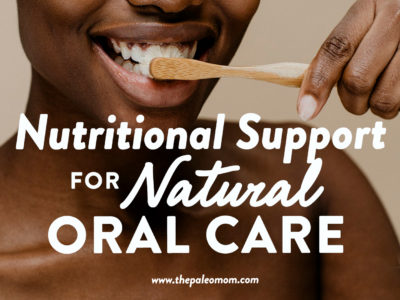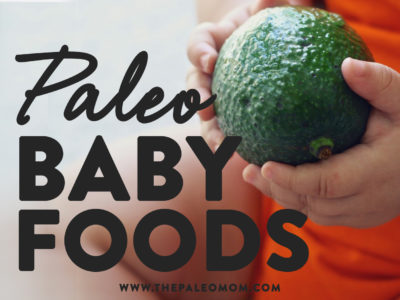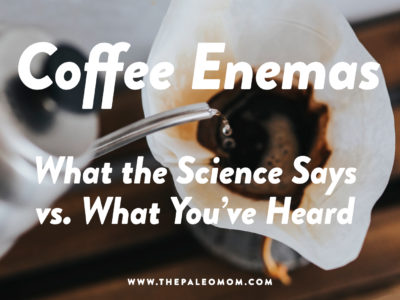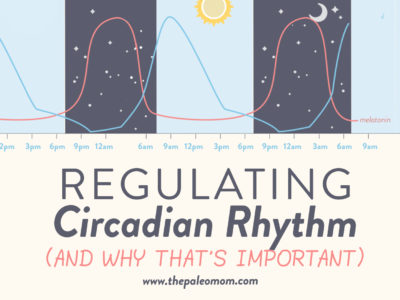 Proper oral care and nutrition can prevent oral infections, such as tooth decay and gum disease, maintaining a healthy mouth for eating, talking, and smiling! In fact, it’s well-established that when our oral health is compromised, we alter our food choices and intake, which can lead to nutritional insufficiencies that increase risk of chronic systemic diseases. Basically, it’s hard to munch down on health-promoting whole foods like carrots and apples when your mouth hurts! There are some more direct systemic reasons to prioritize brushing, flossing, and regular dentist visits too. Research has shown that pathogenic bacteria in the mouth can enter the bloodstream and infect the heart, causing endocarditis, or enter the lungs, causing pneumonia and other respiratory infections. Oral infections are also linked to adverse pregnancy outcomes, cardiovascular disease, and diabetes.
Proper oral care and nutrition can prevent oral infections, such as tooth decay and gum disease, maintaining a healthy mouth for eating, talking, and smiling! In fact, it’s well-established that when our oral health is compromised, we alter our food choices and intake, which can lead to nutritional insufficiencies that increase risk of chronic systemic diseases. Basically, it’s hard to munch down on health-promoting whole foods like carrots and apples when your mouth hurts! There are some more direct systemic reasons to prioritize brushing, flossing, and regular dentist visits too. Research has shown that pathogenic bacteria in the mouth can enter the bloodstream and infect the heart, causing endocarditis, or enter the lungs, causing pneumonia and other respiratory infections. Oral infections are also linked to adverse pregnancy outcomes, cardiovascular disease, and diabetes.
Table of Contents[Hide][Show]
We can consider oral health as a prerequisite for whole-body health. So let’s examine the links between oral health, nutrition and holistic oral hygiene.
The Basics: Tooth Anatomy, Plaque and the Oral Microbiome
 There are two main parts of our teeth, the part you see that is above the gums, called the crown, and the part that you (hopefully) don’t see below the gums, called the root. The crown of the tooth is the surface we use for mastication (chewing), speech, and facial expressions. The root of the tooth not only anchors the tooth to your jawbone (via periodontal ligaments) but also provides a passageway (called the root canal) for nerves and the tiny blood vessels that supply the interior of the tooth. Teeth are also stabilized in place by the gingiva, i.e., gum tissue. The transition between crown and root of the tooth at the gum line is an area called the dental cervix or the tooth neck.
There are two main parts of our teeth, the part you see that is above the gums, called the crown, and the part that you (hopefully) don’t see below the gums, called the root. The crown of the tooth is the surface we use for mastication (chewing), speech, and facial expressions. The root of the tooth not only anchors the tooth to your jawbone (via periodontal ligaments) but also provides a passageway (called the root canal) for nerves and the tiny blood vessels that supply the interior of the tooth. Teeth are also stabilized in place by the gingiva, i.e., gum tissue. The transition between crown and root of the tooth at the gum line is an area called the dental cervix or the tooth neck.
Save 80% Off the Foundations of Health
Expand your health knowledge on a wide range of topics relevant to you, from how to evaluate scientific studies, to therapeutic diet and lifestyle, to leaky gut and gut microbiome health, to sustainable weight loss, and much more!!!
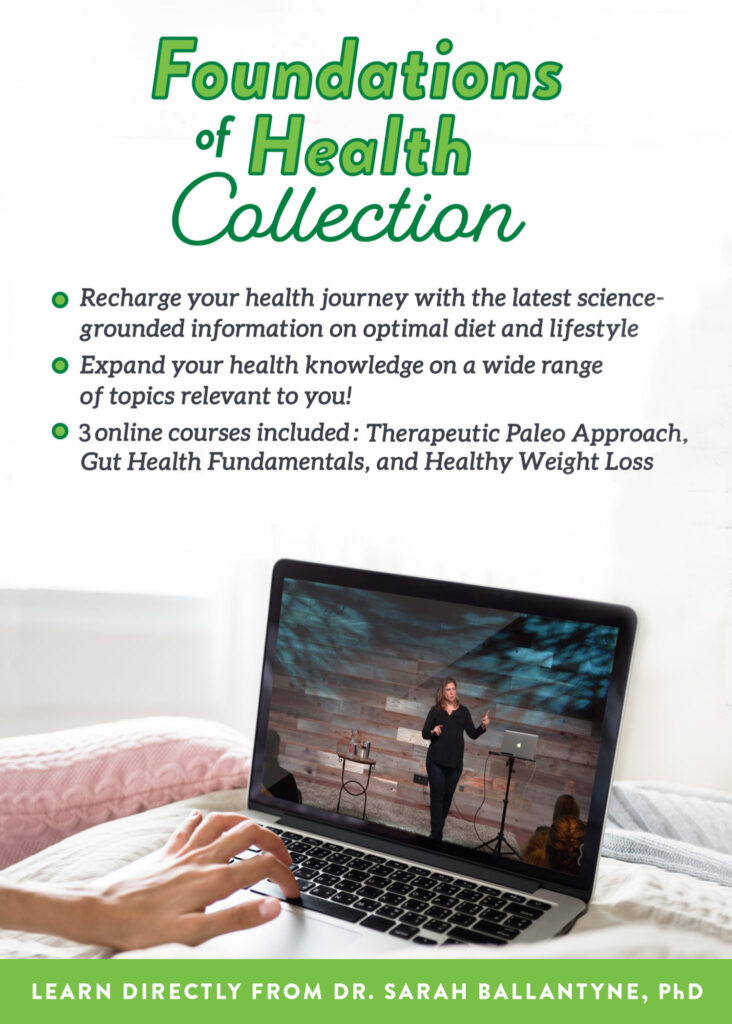
Teeth are composed of three main layers of tissue.
The outermost layer of the tooth is a hard mineral layer—enamel is the outermost layer of the crown and cementum is the outermost layer of the root (the transition between enamel and cementum occurs at the dental cervix). Fun fact: Enamel is actually the hardest tissue produced by any biological process—its hardness of 3.5 GigaPascals (GPa) is due to its crazy high (96%!) mineral concentration, mainly hydroxyapatite, the crystal of calcium phosphate that is also the main mineral precipitate in bone (see also The Paleo Diet for Skeletal Health).
The middle (and largest) layer of the tooth is called dentin. It is made up of hard tissue (albeit not as hard as enamel or cementum, since it’s only about 72% hydroxyapatite by weight, a very similar concentration to bone) that is porous thanks to containing dentinal tubules, which are microscopic channels that radiate from the underside of the enamel surface to the innermost layer of the tooth (called the pulp, spoiler alert for the next paragraph) and which allow important nutrients and cellular processes to permeate throughout the tooth. The main protein in dentin is type I collagen, accounting for approximately 90% of the organic matrix in dentin, see also Gelatin vs Collagen vs Bone Broth.
The innermost layer of the tooth is called the pulp, the soft tissue center of the tooth made up of connective tissue (about half and half types I and III collagen, see Gelatin vs Collagen vs Bone Broth) that contains odontoblasts (the cells that form dentin and whose processes can be found in dentinal tubules, very analogous to osteoblasts in bone, see The Paleo Diet for Skeletal Health), sensory nerves (have you ever noticed that your teeth can tell you if something you’re eating is hot or cold?), and blood vessels that supply the nutrients that are essential for maintaining healthy teeth.
 A variety of nutrients are required to support odontoblast activity, mineralization of dentin and enamel, and the health of gum tissue. In fact, deficiencies in vitamins A, B6, B9, B12, C, and D, as well as calcium, magnesium, phosphorous, zinc and protein have all been associated with oral health problems, although studies on efficacy of supplementation to reverse oral health problems associated with specific nutrient deficiencies have yielded mixed results. There’s also emerging evidence, although more studies are needed, suggesting important roles for additional nutrients, including copper, iron, tin, iodine and vitamins B1, B2, E and K2. Given the structural similarity between teeth and bones, it should come as no surprise that this list of essential nutrients for oral health overlaps substantially with the essential nutrients for skeletal health, see The Paleo Diet for Skeletal Health.
A variety of nutrients are required to support odontoblast activity, mineralization of dentin and enamel, and the health of gum tissue. In fact, deficiencies in vitamins A, B6, B9, B12, C, and D, as well as calcium, magnesium, phosphorous, zinc and protein have all been associated with oral health problems, although studies on efficacy of supplementation to reverse oral health problems associated with specific nutrient deficiencies have yielded mixed results. There’s also emerging evidence, although more studies are needed, suggesting important roles for additional nutrients, including copper, iron, tin, iodine and vitamins B1, B2, E and K2. Given the structural similarity between teeth and bones, it should come as no surprise that this list of essential nutrients for oral health overlaps substantially with the essential nutrients for skeletal health, see The Paleo Diet for Skeletal Health.
Oral health is also strongly influenced by its immediate environment, which is where plaque and the oral microbiome come in.
When saliva, food particles and the bacteria that live in our mouth combine, a sticky biofilm called dental plaque is formed. Dental plaque coats all of the surfaces within the mouth, including teeth and gums, and forms a stable matrix for bacteria and other microbes to adhere and live.
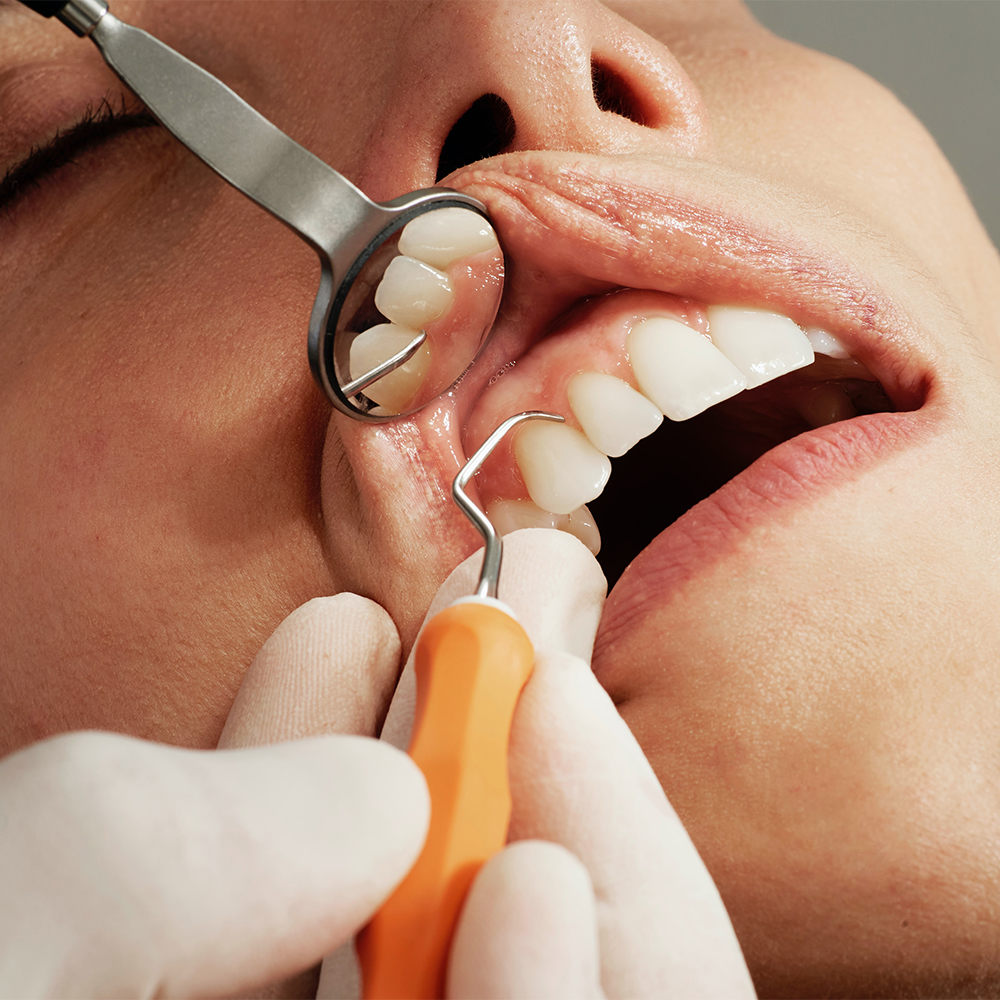 The impact of plaque on oral health is dependent on the composition and metabolic activity of the oral microbiome (see also What Is the Gut Microbiome? And Why Should We Care About It?). Approximately 700 different species of bacteria, fungi and archaea call our mouths home (although we each typically only harbor about 200 species), and they serve as part of our microbial barriers—those friendly symbionts that inhibit the colonization of infectious organisms which can make us sick. However an imbalanced or dysbiotic oral microbiome can harbor greater amounts of harmful species—including Streptococcus mutans, Streptococcus sobrinus, Porphyromonas gingivalis, Treponema denticola, Tannerella forsythia and Aggregatibacter actinomycetemcomitans (try saying that five times fast, or even one time slow!)—that cause tooth and gum disease.
The impact of plaque on oral health is dependent on the composition and metabolic activity of the oral microbiome (see also What Is the Gut Microbiome? And Why Should We Care About It?). Approximately 700 different species of bacteria, fungi and archaea call our mouths home (although we each typically only harbor about 200 species), and they serve as part of our microbial barriers—those friendly symbionts that inhibit the colonization of infectious organisms which can make us sick. However an imbalanced or dysbiotic oral microbiome can harbor greater amounts of harmful species—including Streptococcus mutans, Streptococcus sobrinus, Porphyromonas gingivalis, Treponema denticola, Tannerella forsythia and Aggregatibacter actinomycetemcomitans (try saying that five times fast, or even one time slow!)—that cause tooth and gum disease.
Furthermore, if dental plaque isn’t removed by effective and regular brushing and flossing, it mineralizes and hardens into tartar, also called dental calculus, a yellow-to-brown deposit that tightly adheres to teeth and that is difficult to remove. (Generally, tartar can only be removed by special tools and the skills of a dental professional.) The low-oxygen microenvironment of tartar is more conducive to the growth of acid-forming problematic bacteria rather than the symbiotic oral microbiome species that are associated with good oral health. This means that oral pathogens can thrive in tartar even when the oral microbiome as a whole is healthy.
Undesirable bacteria in plaque and tartar produce organic acids (as metabolic byproducts as they ferment sugars) that solubilize hydroxyapatite, eroding enamel through demineralization. (Consuming acidic beverages and food, as well as high sugar intake, accelerates this process. We’ll talk more about that below.) This enamel erosion weakens the teeth so they are more likely to wear down over time and to crack or chip if damaged. Symptoms such as high tooth sensitivity to hot, cold, or pressure, and/or pain can indicate enamel erosion. And of course, periopathogenic bacteria can colonize the demineralized areas of the tooth, creating a localized area of higher demineralization through acid formation, which eventually penetrates into the dentin, which is what we call a cavity or dental caries. (Fun fact: the word caries is both singular and plural!) These bacteria can
also inflame and damage gum tissue leading to gingivitis and receding gums. And, the accumulation of tartar can lead to more serious dental decay and periodontal disease.
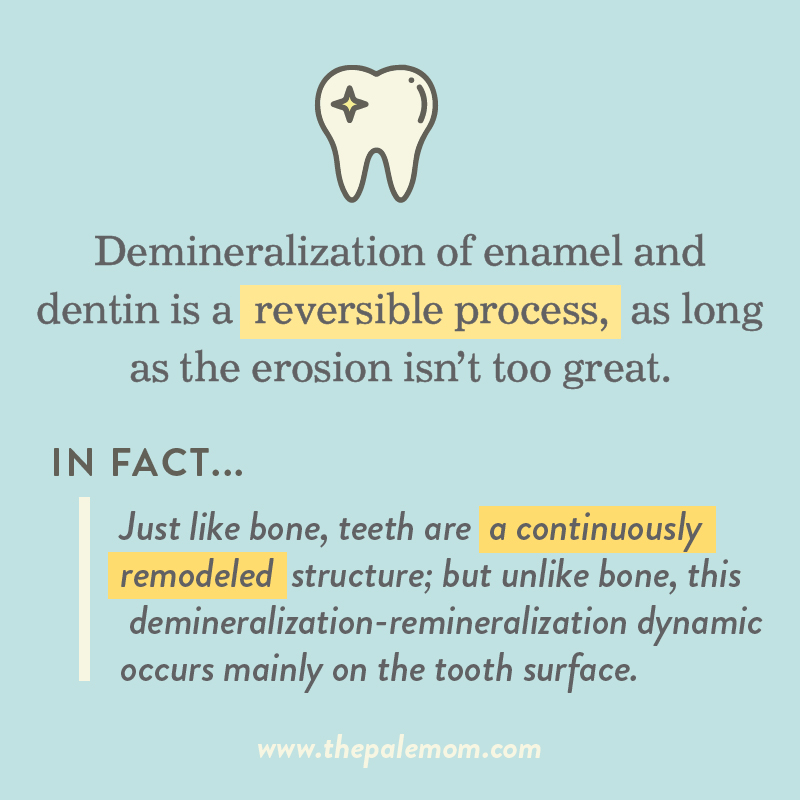 Here’s some good news: Demineralization of enamel and dentin is a reversible process, as long as the erosion isn’t too great. In fact, just like bone, teeth are a continuously remodeled structure; but unlike bone, this demineralization-remineralization dynamic occurs mainly on the tooth surface. The cells that make enamel, called ameloblasts, are only present during tooth development, which is why we can’t regrow a chipped tooth and if you grind your teeth down to the dentin layer, dental crowns or caps are in your future. However, partially demineralized hydroxyapatite crystals in tooth enamel can regrow to their original size if they are exposed to an oral environment that favors remineralization. And yes, we’ll be going into this in lots more detail.
Here’s some good news: Demineralization of enamel and dentin is a reversible process, as long as the erosion isn’t too great. In fact, just like bone, teeth are a continuously remodeled structure; but unlike bone, this demineralization-remineralization dynamic occurs mainly on the tooth surface. The cells that make enamel, called ameloblasts, are only present during tooth development, which is why we can’t regrow a chipped tooth and if you grind your teeth down to the dentin layer, dental crowns or caps are in your future. However, partially demineralized hydroxyapatite crystals in tooth enamel can regrow to their original size if they are exposed to an oral environment that favors remineralization. And yes, we’ll be going into this in lots more detail.
Phew! Now that we have a good understanding of the factors that influence oral health, let’s dig into how to prevent and reverse oral health problems, both from the inside-out, and the outside-in.
Inside-Out: Nutrition for Healthy Teeth and Gums
Nutrition is a key factor in oral health. This includes both avoiding or limiting foods and drinks that damage our teeth and gums as well as supplying the essential nutrients needed for healthy oral tissues.
Foods and Beverages that Damage Teeth
 Consumption of acidic beverages—especially those with high concentrations of citric acid, phosphoric acid, ascorbic acid, malic acid, tartaric acid and carbonic acids (which are found in soft drinks, fruit juices, some herbal teas, vinegar and dry wines)—increases dental erosion.
Consumption of acidic beverages—especially those with high concentrations of citric acid, phosphoric acid, ascorbic acid, malic acid, tartaric acid and carbonic acids (which are found in soft drinks, fruit juices, some herbal teas, vinegar and dry wines)—increases dental erosion.
Saliva, which has a normal pH in the range of 6.2 to 7.6, has a buffering capacity, so under normal circumstances when we consume a mildly acidic food or beverage, our saliva secretions increase in response and neutralizes acids on the tooth surface, clearing them when we swallow, and thereby protecting against erosion. In addition, saliva acts as a supersaturated and constant source for calcium and phosphate (as well as a glycoprotein that catalyzes mineralization called salivary precipitin) to promote remineralization of enamel when the pH returns to a neutral state. This is why saliva deficiency, called xerostomia, is associated with so many oral health problems.
Foods and beverages with pH less than 5.5 are more acidic than saliva’s buffering capacity so they can demineralize enamel and cause mild dental erosion. Foods and beverages with a pH less than 3 (like soft drinks and many sports drinks and energy drinks) are extremely erosive. Concurrent high sugar (especially sucrose) intake makes it worse by increasing plaque volume, driving development and progression of periodontal diseases. Soft drinks are a double whammy here, which is why excessive consumption of soft drinks is strongly associated with dental erosion, but this is also why fruit juice consumption is associated with increased dental carries in kids. It also makes matters worse if you hold the beverage in your mouth before swallowing—yeah, try not to do that.
 Many drinks that are otherwise healthy, like tea, coffee and mineral water (see The Health Benefits of Tea, Coffee as a Mediator of Health & Longevity and Water Quality and the Gut Microbiome), have a low enough pH to be at least mildly or moderately erosive to our teeth. So, let’s talk about how to safely continue consuming health-promoting beverages that have some erosive capacity for our teeth. While it may seem logical to brush our teeth immediately after consuming these beverages as a preventative measure against dental erosion, studies have actually shown that this increases demineralization. Basically, we’re brushing away partially-solubilized minerals that might have re-crystalized in our enamel if we had given our saliva a little time to work. Waiting about 30 minutes before brushing is preferable in addition to taking other measures to support oral health, like proper oral hygiene and nutrient intake. That brings me to nutrition for oral health…
Many drinks that are otherwise healthy, like tea, coffee and mineral water (see The Health Benefits of Tea, Coffee as a Mediator of Health & Longevity and Water Quality and the Gut Microbiome), have a low enough pH to be at least mildly or moderately erosive to our teeth. So, let’s talk about how to safely continue consuming health-promoting beverages that have some erosive capacity for our teeth. While it may seem logical to brush our teeth immediately after consuming these beverages as a preventative measure against dental erosion, studies have actually shown that this increases demineralization. Basically, we’re brushing away partially-solubilized minerals that might have re-crystalized in our enamel if we had given our saliva a little time to work. Waiting about 30 minutes before brushing is preferable in addition to taking other measures to support oral health, like proper oral hygiene and nutrient intake. That brings me to nutrition for oral health…
Nutrients for Oral Health
Let’s discuss the most important, best-studied nutrients to consume in adequate quantities for oral health.
Vitamin A is essential for bone growth, tooth remineralization, skin health, vision, reproduction, immune function and maintenance of health in many epithelial cells. Low vitamin A intake is associated with impaired tooth and gum development, reduced formation of enamel, and periodontitis (infection of the gums). Vitamin A (retinol form) is abundant in liver, eggs, quality dairy products, and seafood (especially shrimp, salmon, sardines, and tuna).
Vitamin B6 is important for cell metabolism and the production of hemoglobin, which carries oxygen in the blood. Vitamin B6 is also important for protein metabolism, synthesis of some amino acids, and it’s vital for producing the key neurotransmitters GABA, dopamine, and serotonin. Deficiency of vitamin B6 causes recurrent mouth ulcers, halitosis (an indicator of oral microbiome dysbiosis), severe gingivitis as well as inflammation of tongue and lips. Rich sources of vitamin B6 include meat, poultry, fish and shellfish as well as many vegetables including potatoes and tomatoes.
Vitamin B9 (folate) plays an important role in methylation (the process of adding a methyl group to different molecules), making it a key player in methylation-dependent processes like detoxification and neuron signaling. Folate is also crucial for cardiovascular health, reproductive function (especially protecting against neural tube defects), and red blood cell production. Low serum folate levels are associated with reduced defenses of periodontal tissue against bacterial infection, leading to periodontitis. Rich sources of folate include organ meat, green vegetables (both leafy and non-leafy), legumes, beets, avocados, and fruits such as papayas, strawberries, and pomegranates.
Vitamin B12 is involved in energy metabolism like the other B vitamins, but also plays a unique role in DNA production. It’s vital for maintaining cardiovascular, brain, and nervous system health. Deficiency of vitamin B12 leads to gingival bleeding and serum vitamin B12 levels inversely correlate with the severity of periodontitis (the lower B12, the worse the periodontitis). Foods abundant in vitamin B12 include fish (especially sardines, salmon, tuna, and cod), shellfish such as shrimp and scallops, organ meat, beef, poultry, and eggs.
Vitamin C is a potent antioxidant necessary for immune system function and the function of several enzymes, including enzymes involved in collagen synthesis, which is why vitamin C deficiency causes scurvy. While inflamed and bleeding gums as well as loose teeth (due to defects in periodontal ligament collagen) are hallmarks of scurvy, inadequate vitamin C intake is also associated with periodontitis. Rich sources of vitamin C include bell peppers, leafy dark green vegetables, citrus fruits, and other fruits such as papaya, cantaloupe, guava, and berries.
Vitamin D is a steroid hormone that is essential for immune system function, bone and tooth development and mineralization, modulation of cell growth, neuromuscular function, and the reduction of inflammation. Vitamin D enhances the intestinal absorption of minerals that are important for oral health, including: calcium, magnesium, iron, phosphate, and zinc. Inadequate serum levels of vitamin D increases the risk of dental caries and periodontal disease. Although vitamin D can be produced when the sun’s UV rays hit the skin and trigger vitamin D synthesis, it also can be obtained from foods, including oily fish (such as salmon, tuna, and mackerel), mushrooms, fish roe, liver, and eggs. Learn more about testing and supplementation here.
Calcium is a main constituent of bones and teeth and is essential to many processes within cells, as well as neurotransmitter release and muscle contraction (including the beating of your heart!). Calcium intake is inversely is associated with dental caries—the less calcium consumed, the higher the risk of dental caries. Foods rich in calcium include dark green vegetables, sesame seeds, dairy products, whole sardines (bones included), and squash.
Phosphorous plays a role in every metabolic reaction in the body and is important for the metabolism of fats, carbohydrates, and proteins. It also serves a central function in bone and tooth support (recall that hydroxyapatite are crystals of calcium phosphate). Phosphorous intake is inversely is associated with dental caries—the less phosphorous consumed, the higher the risk of dental caries. Phosphorous is abundant in protein-rich foods such as dairy products, fish, shellfish, seeds, and legumes.
Magnesium is required for more than 300 different enzymes to work, including every enzyme that uses or synthesizes ATP (the basic energy molecule in a cell) and enzymes that synthesize DNA and RNA. Magnesium also enhances control of inflammation and maintains nervous system balance. Similar to calcium and phosphorous, low magnesium intake is associated with increased risk of dental carries. Studies have shown that taking calcium without magnesium results in soft dental enamel that erodes more easily when exposed to acids. Foods rich in magnesium include green vegetables, nuts and seeds, fish, legumes, and avocados.
Zinc is important for nearly every cellular function, from protein and carbohydrate metabolism to cell division and growth. Zinc also plays a role in skin health and the maintenance of sensory organs (that’s why zinc deficiency is associated with a loss of smell and taste) and is a vital nutrient for immune system function. Zinc also plays a vital role in epithelial barrier function by improving tight junction formation. Studies have shown that zinc reduces the dissolution rates of hydroxyapatite in enamel and inhibits tartar formation. The richest source of zinc is oysters, but other good sources include red meat, poultry, nuts and seeds, and legumes.
Protein deficiency is detrimental to all of the body’s organs and systems, and given that gingival tissue has one of the highest turnover rates in the human body, it’s no surprise that one of the symptoms of protein malnutrition is tooth loss and periodontal lesions. There’s also an inverse relationship between protein intake and periodontitis, higher protein intake reduces risk of periodontal infections.
It’s worth noting that, with the exception of treating scurvy with vitamin C and addressing gross malnutrition, supplementation doesn’t generally seem very helpful in reversing periodontal disease linked with nutrient deficiencies. In this case, an ounce of prevention is worth a pound of cure, so we’re better off simply eating a nutrient-sufficient diet on the regular to prevent oral health problems. See also The Importance of Nutrient Density and TWV Podcast Episode 437: Intro To Nutrivore.
Probiotics for Oral Care
There are some probiotic species that have been shown to improve oral health, including Lactobacillus salvarius, Lactobacillus reuteri, Lactobacillus rhamnosus and Bifidobacterium species, at least in part by suppressing the growth or cariogenic species like Streptococcus mutans. The challenge is that we still don’t know the best way to introduce these probiotic species to the oral microbiome. There are some new lozenges and chewing gums that include these strains that are being marketed for the prevention or treatment of periodontal disease, however more studies are needed to verify benefits!
Inflammation and Oral Health
Inflammation is a key feature of periodontal disease, but it may also drive tooth decay through internal demineralization. In bone, two cell types are responsible for the constant remodeling of bone matrix—osteoblasts mineralize and osteoclasts demineralize—ideally working in equilibrium with each other, see The Paleo Diet for Skeletal Health. In adult/permanent teeth, odontoblasts form dentin, mineralizing the teeth from the inside, but odontoclasts exhibit very little activity. (Odontoclasts help break down the root of baby teeth, but once we have our permanent teeth, odontoclasts are done their job.) In contrast to bone, the forces of demineralization of adult teeth are mainly external: acidic food and drink as well as the organic acids produced as metabolic byproducts by oral bacteria as they ferment sugars.
Here’s the rub: Chronic inflammation stimulates the genesis of odontoclasts, which can lead to demineralization of teeth from the inside and to internal root resorption, which causes the loss of the tooth. So, anti-inflammatory diet and lifestyle are a necessary additional focus for oral health. There’s a metric ton of information on how dietary factors and lifestyle choices impact immune function and inflammation on this site, but for a starting place, see the Autoimmune Protocol.
Outside-In: Oral Hygiene and Oral Care Products
It was a long walk, but we’re finally here: the importance of brushing and flossing our teeth! Of course, there’s a lot of choice in oral care products, and the science indicates that they aren’t all created equal, so let’s dig into the details.
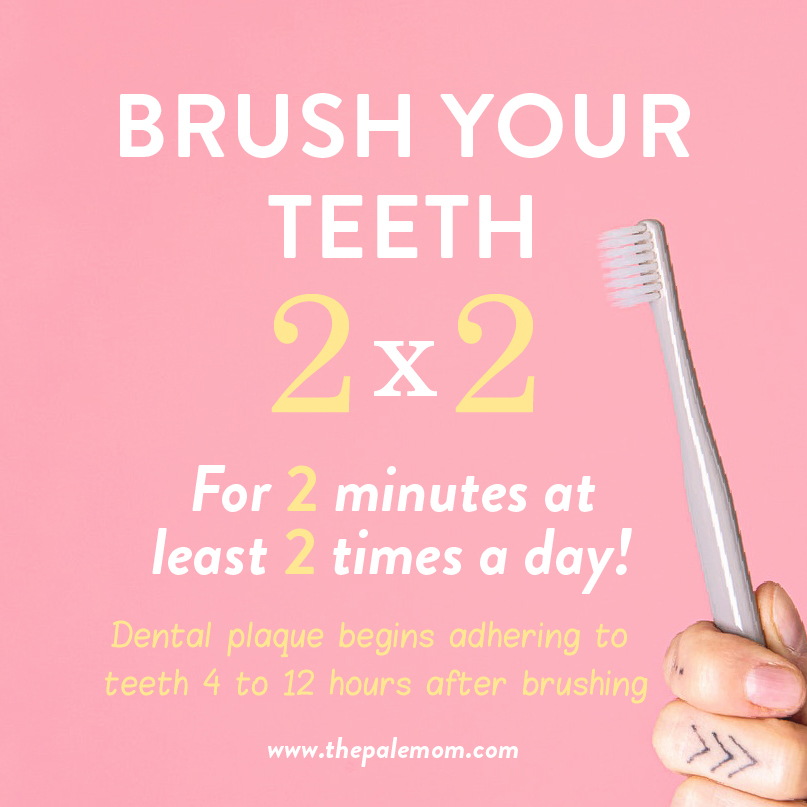 Brush Your Teeth 2×2
Brush Your Teeth 2×2
Dental plaque begins adhering to teeth 4 to 12 hours after brushing, which is why it is so important to brush thoroughly for two minutes at least twice a day—2 by 2.
Let’s break that down. A 2016 systematic review confirmed that brushing less than twice per day is consistently associated with more tooth decay than brushing twice a day or more. A 2012 systematic review found that manual tooth brushing for two minutes removes about twice as much plaque as brushing for one minute (removing 42% of plaque on average compared to 27%). And a 2019 systematic review showed that powered toothbrushes were marginally better (about 10%) than manual tooth brushes, so brushing for longer and regularly is more important than what toothbrush you use.
Many powered toothbrushes will beep or pulse every 30 seconds, prompting you to move to a different quadrant of your mouth (upper right, upper left, lower right, lower left, but don’t forget the front teeth!) and signal when two minutes is up. (In fact, the benefit of powered toothbrushes might be more related to the fact that they encourage you to brush longer rather than them being better at removing plaque!) If you’re using a manual toothbrush, setting a timer can be very helpful (or you can sing the Raffi song Brush Your Teeth in your head—it’s just about the right length)!
If you’re looking for an eco-friendly recommendation for a manual toothbrush, I love Primal Life Organics Toothbrushes. The bristles are made of charcoal-infused bamboo (which helps remove stains, is tough enough to remove plaque but soft enough not to damage enamel) and the handles are also made of bamboo! They’re also fully biodegradable!
Toothpaste and Toothpowder
Okay, let’s talk toothpaste. Fluoride, while controversial, has been conclusively shown to reduce dental caries when applied topically, as in toothpastes and fluoride treatments your dentist may give. Fluoride replaces the calcium in the hydroxyapatite crystal which reduces its solubility, decreasing enamel erosion and acting as a catalyst for remineralization (learn more here). But, fluoride isn’t the only show in town when it comes to preventing caries and it’s important to call-out the fact that commercial fluoridated toothpastes tend to contain a wide range of problematic ingredients, including sweeteners (see Is It Paleo? Splenda, Erythritol, Stevia and other low-calorie sweeteners), emulsifiers (see Is It Paleo? Guar Gum, Xanthan Gum and Lecithin, Oh My!), and all of the following:
- Sodium lauryl sulfate acts as a foaming agent, detergent and antimicrobial in toothpaste. While it assists in spreading toothpaste around your mouth and in removing food particles from teeth, it also kills probiotic bacteria species in the mouth, disrupting the oral microbiome. It’s also unnecessary in toothpaste—a 2016 study showed that toothpastes without SLS were just as effective at removing plaque and improving gum health.
- Hydrated silica is added as an abrasive to toothpastes to aid in stain removal. But, toothpaste only needs to be mildly abrasive to be effective and hydrated silica is so abrasive that it damages enamel and dentin, actually contributing to enamel erosion which increases tooth sensitivity and can lead to gum recession.
- Parabens are added to toothpaste to act as a preservative. Parabens are known endocrine disruptors, mimicking the hormone estrogen, and have been linked to cancer, developmental, and reproductive issues.
- Hydrogen peroxide (sometimes in the form of carbamide peroxide) is a common ingredient in whitening toothpastes as well the active ingredient in most teeth whitening products. While hydrogen peroxide certainly can bleach teeth, it penetrates the enamel and dentin, damaging the collagen matrix, which demineralizes and softens enamel and dentin, weakening the teeth as a result, even increasing risk of root resorption! It’s also a well-known gum irritant and may be carcinogenic! This is important enough, we’re going to talk about this again when we talk about the benefits of LED teeth whitening below.
Ick.
So let’s discuss ingredients found in natural toothpastes and toothpowders, including which have (and don’t have) science to support them.
 Baking soda (sodium bicarbonate), by approximately a million miles (that’s an appropriate unit of measurement here, right?), has the most science to support its use as a natural tooth cleaner. It effectively removes plaque but it isn’t abrasive so it doesn’t damage the enamel or dentin. Studies have also shown that baking soda selectively kills bacteria associated with dental caries, including Streptococcus mutans, without disrupting the entire oral microbiome. AND, because it neutralizes plaque acids, it not only protects against enamel erosion and dental caries, but it can even facilitate remineralization of tooth enamel! This last fact is why you see a lot of natural toothpastes and toothpowders include both baking soda and clays (such as bentonite, kaolin, and French green clay), because they help to supply the minerals (calcium, phosphorous, potassium, magnesium, zinc, and iron) that are known to be important for remineralizing enamel in addition to adding another mild abrasive ingredient for removal of plaque. In fact, a couple of studies have shown that traditional toothpowders can be even better than commercial toothpastes at reducing dental caries and gum disease, likely because of this combination of minerals and acid neutralization, but more studies are certainly needed, especially given the wide range of ingredients in natural toothpowders and toothpastes.
Baking soda (sodium bicarbonate), by approximately a million miles (that’s an appropriate unit of measurement here, right?), has the most science to support its use as a natural tooth cleaner. It effectively removes plaque but it isn’t abrasive so it doesn’t damage the enamel or dentin. Studies have also shown that baking soda selectively kills bacteria associated with dental caries, including Streptococcus mutans, without disrupting the entire oral microbiome. AND, because it neutralizes plaque acids, it not only protects against enamel erosion and dental caries, but it can even facilitate remineralization of tooth enamel! This last fact is why you see a lot of natural toothpastes and toothpowders include both baking soda and clays (such as bentonite, kaolin, and French green clay), because they help to supply the minerals (calcium, phosphorous, potassium, magnesium, zinc, and iron) that are known to be important for remineralizing enamel in addition to adding another mild abrasive ingredient for removal of plaque. In fact, a couple of studies have shown that traditional toothpowders can be even better than commercial toothpastes at reducing dental caries and gum disease, likely because of this combination of minerals and acid neutralization, but more studies are certainly needed, especially given the wide range of ingredients in natural toothpowders and toothpastes.
A few other ingredients can often be found in natural toothpowders and toothpastes.
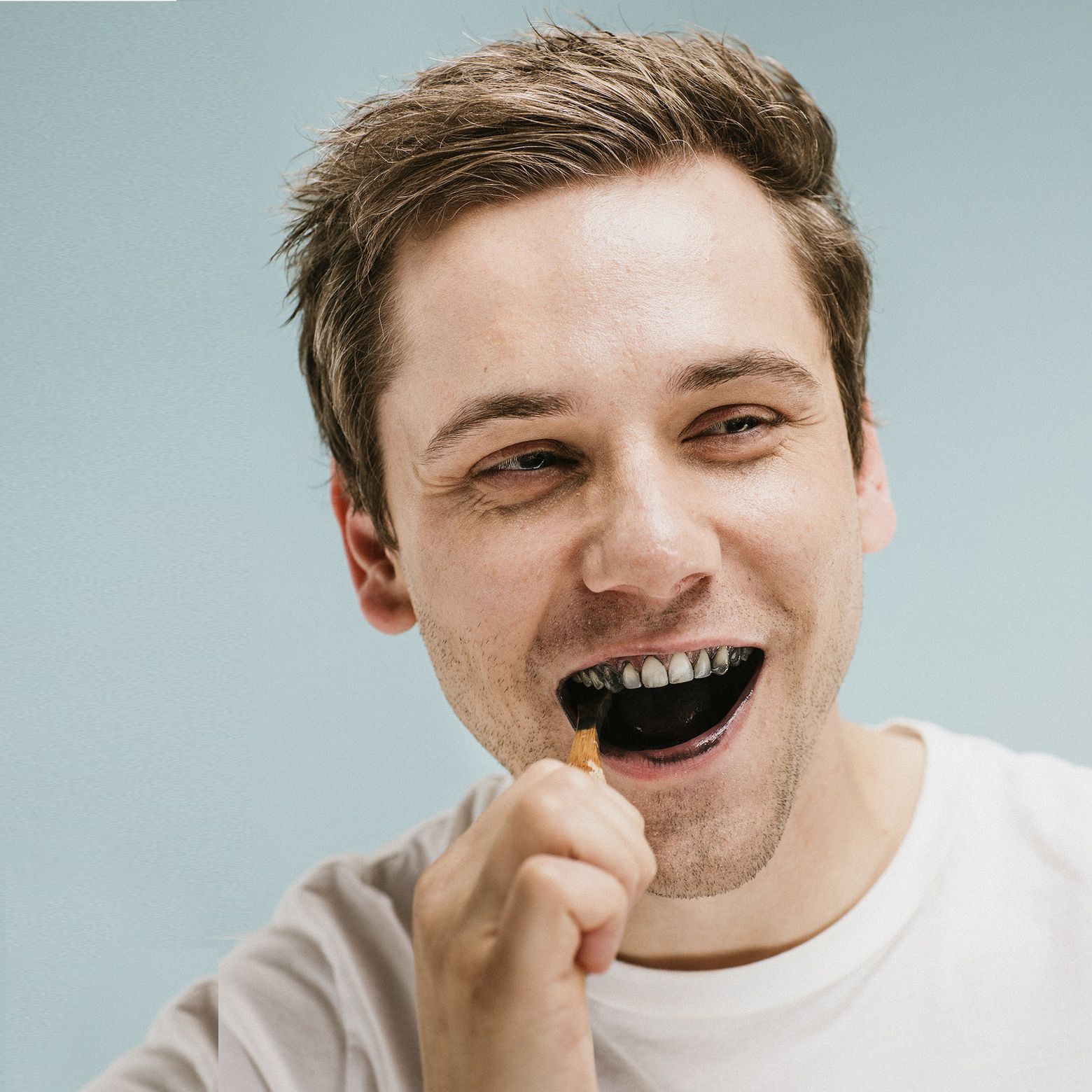 Charcoal can help remove stains but doesn’t whiten teeth and doesn’t do anything to improve enamel or oral health in general. It’s okay as an ingredient in natural toothpaste or toothpowder, but shouldn’t be the only ingredient. (Studies have shown that activated charcoal-based toothpowders don’t protect against dental carries.)
Charcoal can help remove stains but doesn’t whiten teeth and doesn’t do anything to improve enamel or oral health in general. It’s okay as an ingredient in natural toothpaste or toothpowder, but shouldn’t be the only ingredient. (Studies have shown that activated charcoal-based toothpowders don’t protect against dental carries.)
Xylitol decreases the growth of cariogenic bacteria, including Streptococcus mutans and Streptococcus sangui, which helps to prevent dental caries. Xylitol can also bind with calcium ions to facilitate remineralization of tooth enamel. Studies show that xylitol is even more effective when paired with remineralization agents—a 2015 Cochrane review showed that adding xylitol to fluoridated toothpaste reduced dental caries by 13% compared to the fluoridated toothpaste without xylitol.
Finally, many natural toothpastes and toothpowders contain essential oils, often simply to act as a flavoring, but sometimes as an antimicrobial. This is a mixed bag, since many essential oils do have antimicrobial and anti-inflammatory properties (they are concentrated sources of phytonutrients), but their effects can be complex and only a handful have been studied in the context of oral health. Certainly the most common essential oils, like peppermint, spearmint, orange and cinnamon, are safe, and as a general rule, if it’s an essential oil derived from an herb or edible plant, you should be good to go. See The Amazing World of Plant Phytochemicals and TPV Podcast, Episode 272: What’s the Deal with Essential Oils?.
My choice is Primal Life Organics Toothpowder (Peppermint is my favorite), which combines aluminum-free baking soda with bentonite clay, kaolin clay, French green clay, activated charcoal (Black Peppermint and Black Spearmint only) and well-studied essential oils like peppermint as a flavor. It’s by far the most effective alternative to commercial toothpaste I’ve ever tried and my teeth have remained healthy and cavity-free for the 6+ years I’ve been using it!
Don’t Forget to Floss!
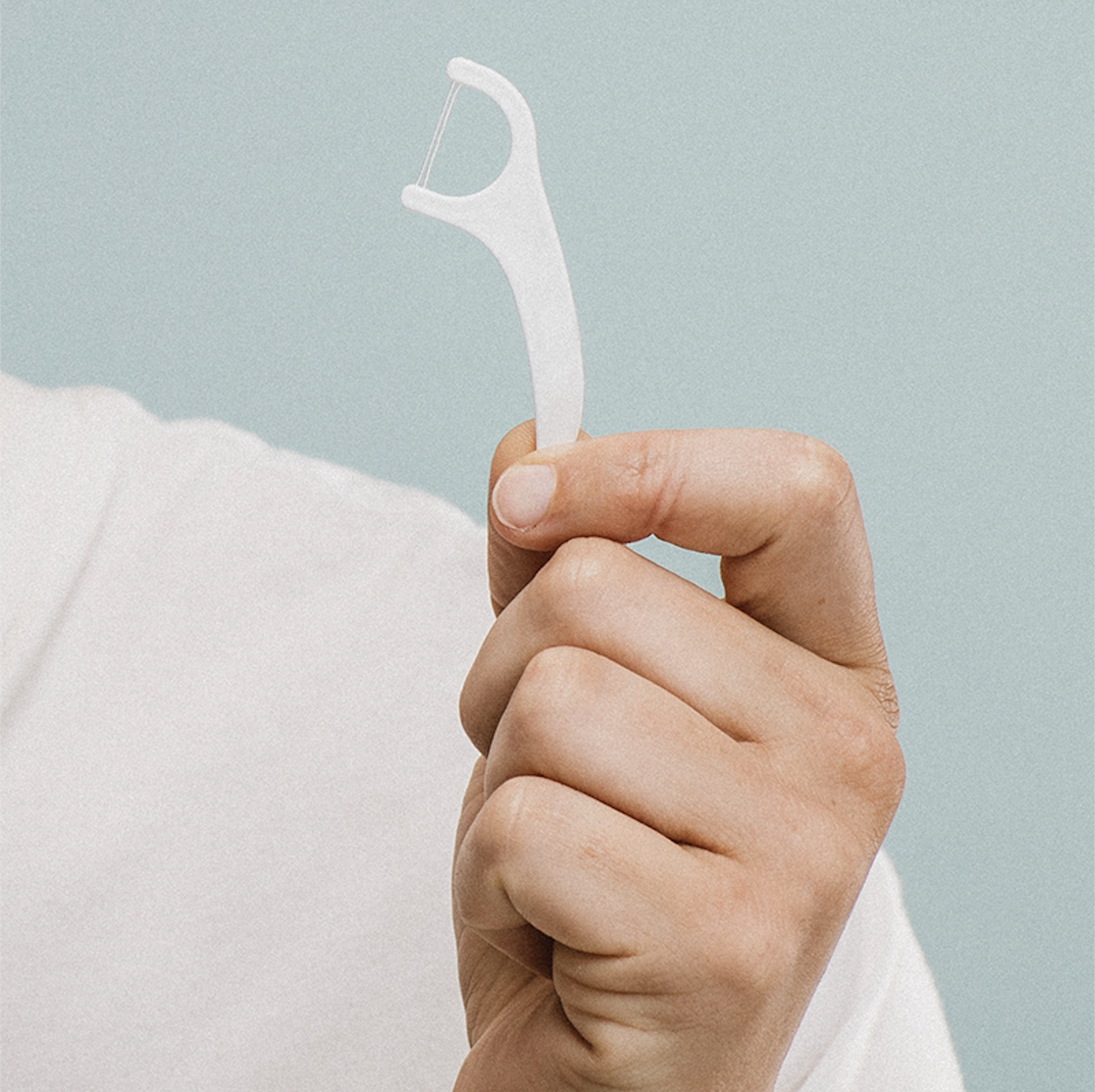 Why floss? It’s not a coincidence that most dental caries occur on the tooth surfaces that face each other; that tight space between teeth where food gets stuck and plaque quickly turns to tartar. Quite simply, our tooth brushes can’t reach the areas between our teeth, so we need to floss daily to remove plaque buildup between our teeth and prevent the formation of tartar, even when we don’t have food stuck between our teeth.
Why floss? It’s not a coincidence that most dental caries occur on the tooth surfaces that face each other; that tight space between teeth where food gets stuck and plaque quickly turns to tartar. Quite simply, our tooth brushes can’t reach the areas between our teeth, so we need to floss daily to remove plaque buildup between our teeth and prevent the formation of tartar, even when we don’t have food stuck between our teeth.
One challenge is that commercial dental floss commonly uses polytetrafluoroethylene, which contains per- and polyfluoroalkyl substances (PFASs), which are also known as “forever chemicals” and are linked to cancer, liver damage, decreased fertility, and increased risk of asthma and thyroid disease, in addition to being generally immunotoxic. PFASs can persist in our bodies for years after exposure. AND, a 2019 study found that women who flossed with Oral-B Glide floss had higher serum levels of a PFAS called perfluorohexane sulfonic acid compared to women who didn’t floss or used non polytetrafluoroethylene-based dental floss.
I love Primal Life Organics Dental Floss Picks—the floss is made from charcoal-infused bamboo coated with a little mint oil and the handle is made from corn starch. Not only is the floss super tough if you happen to have teeth that are really close together like mine, but the charcoal is very helpful for removing stains and keeping the area between teeth clean!
Need some help making daily flossing a habit? Then check out Habit Formation and New Years Resolutions.
Skip the Mouthwash
Commercial mouthwashes use alcohol, cetylpyridinium chloride, chlorhexidine, and/or triclosan as antimicrobials. The problem? Sterilizing the mouth with strong non-selective antimicrobials wipes out the probiotic bacteria in addition to potential pathogens. This is especially relevant when you consider that only about 3% of the species in the oral microbiome can cause oral health problems when their growth is unchecked. Losing all of our probiotic species for the sake of killing off the problematic minority is not a good trade! Studies have confirmed an indiscriminate loss of probiotic oral microbiome species with a wide variety of mouthwashes (including all of the major brands and major antimicrobial ingredients). A 2020 study of chlorhexidine-based mouthwash showed that 7 days of use resulted in the loss of probiotic species in the oral microbiome that reduced the buffering capacity of saliva, lowering saliva pH. Not cool! Furthermore, studies have also shown that chlorhexidine and cetylpyridinium chloride-based mouthwashes stimulate inflammation in mouth epithelial tissues, like our gums! Seriously, how did mouth wash ever become a thing?!
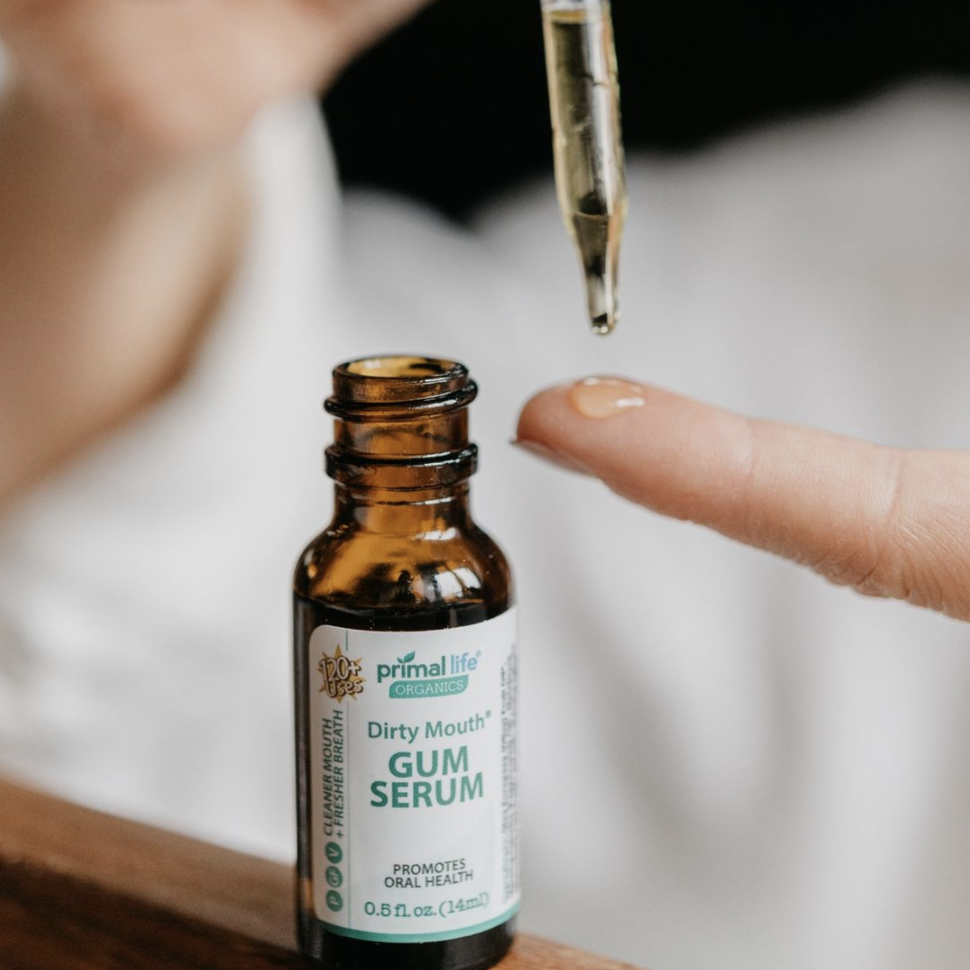 What’s a good alternative? A 2015 meta-analysis showed that essential oil containing mouthwashes reduced gingivitis by 16% and plaque by 28% with daily use over 6 months compared to not using mouthwash.
What’s a good alternative? A 2015 meta-analysis showed that essential oil containing mouthwashes reduced gingivitis by 16% and plaque by 28% with daily use over 6 months compared to not using mouthwash.
Another alternative that is certainly trending in alternative health communities is oil pulling, whereby you take about a tablespoon of a cold-pressed oil and swish it around in your mouth for up to 20 minutes. While sesame oil is traditionally used, extra virgin olive oil and coconut oil have become popular modern choices because of their polyphenols, high vitamin content and natural selective antimicrobial activity against Streptococcus mutans and Candida albicans. There certainly are some studies showing that oil pulling (including with olive oil, coconut oil, almond oil, and sesame oil) can reduce gingivitis and prevent dental caries, although many of the other health claims about oil pulling (like heavy metal detoxification) are not supported in the scientific literature.
My personal choice is Primal Life Organics Gum Serum, an olive oil and essential oil-based concentrated mouthwash. You can add a couple of drops to a mouthful of water and swish like normal mouthwash, or add a couple of drops directly to your mouth and let if fill with saliva before swishing, or add a drop or two to your favorite cold-pressed oil for oil pulling.
Skip the Whitening Strips and Switch to LEDs!
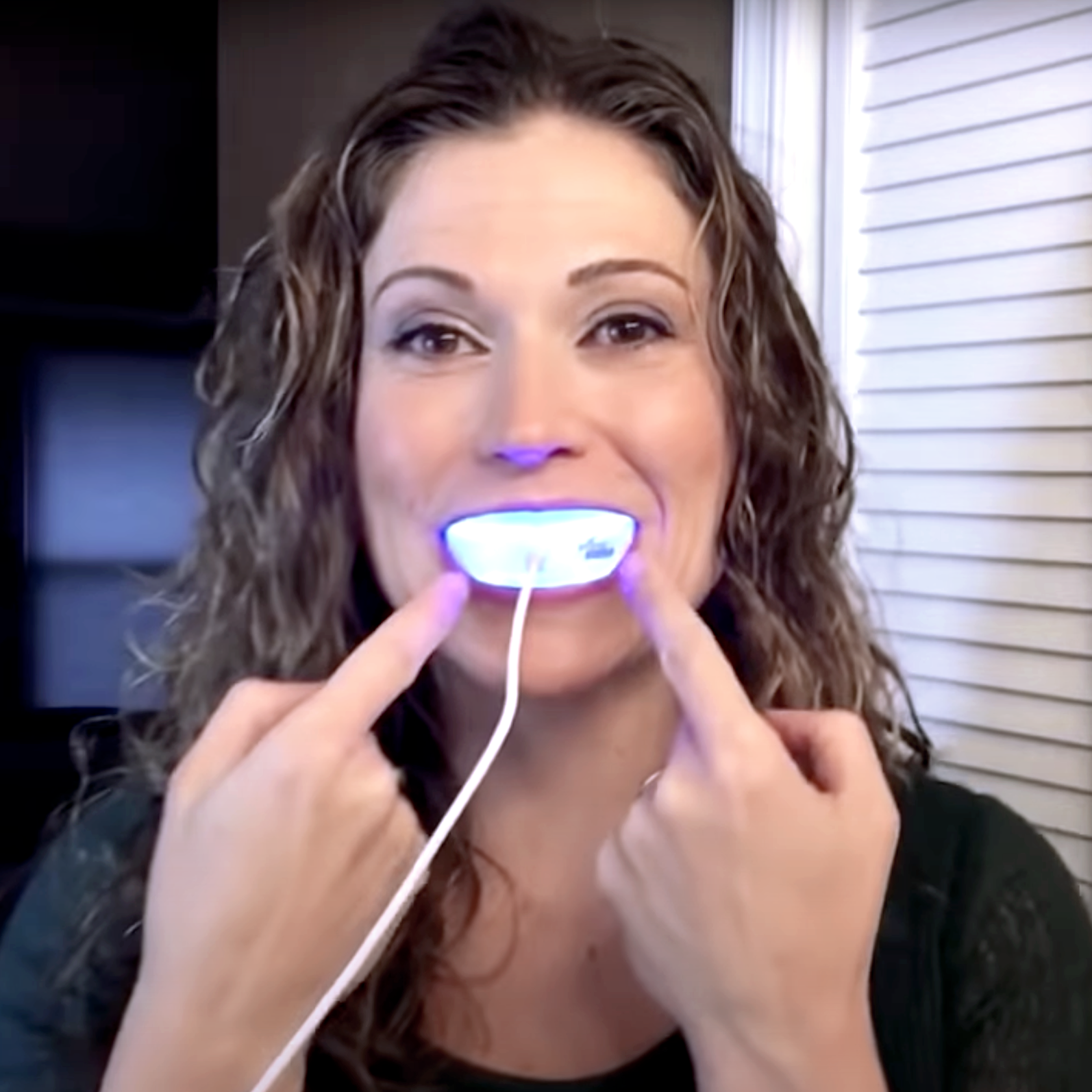 One last thing to discuss, and that’s teeth whitening. Remember all the way back when we discussed toothpaste how terrible hydrogen peroxide is for tooth health? Let’s talk about light therapy for our mouths and how this technology can both naturally whiten our teeth AND improve our tooth and gum health! Yep, you read that right!
One last thing to discuss, and that’s teeth whitening. Remember all the way back when we discussed toothpaste how terrible hydrogen peroxide is for tooth health? Let’s talk about light therapy for our mouths and how this technology can both naturally whiten our teeth AND improve our tooth and gum health! Yep, you read that right!
Low level laser and light therapy have been extensively studied for use in dentistry, with new innovative options to bring these technologies into our homes for daily use. The best outcomes are with the combination of blue and red wavelengths, like what are delivered by Primal Life Organics Real White LED Teeth Whitening System, which confer complimentary benefits to oral health.
As a reminder, when chromophores inside our mitochondria absorb photons of specific wavelengths, their electrons get excited and leap into a higher-energy orbit. The result is newly available energy that our bodies can use for a variety of cellular tasks, including turning on beneficial genes and synthesizing important proteins. Among the benefits of red light are reduced inflammation and speedier wound healing, so it’s no surprise that red light has been shown to improve gum health! Red light has been successfully used to treat gingivitis and periodontitis. In one study, participants with mild periodontitis brushed with toothbrush fitted with a red LED light twice daily. After 2 weeks, gum health was measurably improved, and after 4 weeks, there was a measurable reduction in plaque! Red light therapy has also been shown to speed up healing after oral surgery.
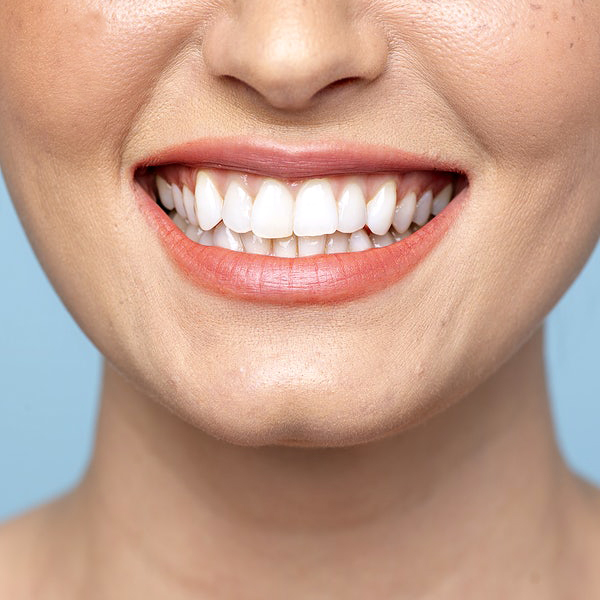 Here’s what’s even cooler about oral red light therapy. A collection of studies have shown that red wavelengths of light stimulate odontoblast activity, so they produce more tooth matrix proteins and activate pathways associated with tissue repair (blue and green light don’t have this affect). In fact, a wide variety of studies have shown that treatment with red light can reduce dental hypersensitivity after oral surgeries and other treatments in the dentist’s office! And, red light can even partially protect against enamel demineralization from hydrogen peroxide treatments (so, let’s ditch the hydrogen peroxide and just enjoy the improved dental health from red light)!
Here’s what’s even cooler about oral red light therapy. A collection of studies have shown that red wavelengths of light stimulate odontoblast activity, so they produce more tooth matrix proteins and activate pathways associated with tissue repair (blue and green light don’t have this affect). In fact, a wide variety of studies have shown that treatment with red light can reduce dental hypersensitivity after oral surgeries and other treatments in the dentist’s office! And, red light can even partially protect against enamel demineralization from hydrogen peroxide treatments (so, let’s ditch the hydrogen peroxide and just enjoy the improved dental health from red light)!
Of course, more studies are needed to show how much remineralization of enamel can occur at various energy densities of red light, but it’s important to note that thin enamel can make teeth look pretty yellow even when they’re stain-free because the translucence of eroding enamel makes the yellow dentin underneath more visible. Stronger, thicker enamel makes for naturally whiter teeth—no bleach needed.
Blue light activates a different subset of chromophores than red light, particularly in iron-based molecules like heme and porphyrin, turning on downstream production of reactive oxygen species, aka oxygen radicals. It turns out that pathogenic oral bacteria tend to have porphyrin-based metabolisms, so blue light selectively kills them! A wide variety of studies have confirmed that blue light suppresses the growth of bacteria responsible for plaque, halitosis, gingivitis and periodontal disease, including Porphyromonas gingivalis, Fusobacterium nucleatum, Prevotell nigrescens and Prevotella intermedia. Red light, in contrast, doesn’t have strong antimicrobial properties, but it has been shown to inhibit the growth of Enterococcus faecalis, a common culprit behind abscesses requiring root canals.
Blue light has been widely used in dentistry in conjunction with bleaching agents like hydrogen peroxide to accelerate teeth whitening, which works through something called a photo-Fenton reaction. Blue or UV light accelerates the production of oxygen radicals by hydrogen peroxide and iron, which breaks down organic molecules that are staining teeth. (This is also why gum protection is typically used with these treatments because the increase in reactive oxygen species can inflame gingival tissue.) What’s interesting is that blue light has also been shown to whiten teeth with titanium dioxide nanoparticles and without hydrogen peroxide or iron, a much safer way to go! Blue light doesn’t bleach teeth on its own (well, studies that have a blue light only control group show a marginal whitening effect compared to no treatment, but it’s way way less than when blue light is used to activate a whitening gel); but, blue light can accelerate the breakdown of staining agents as well as suppress the growth of dark-colored bacteria that grow in plaque. The whitening effect of blue light is more accurately described as cleaning rather than bleaching.
 Using the Primal Life Organics LED Teeth Whitening System combines the benefits of blue and red light for oral health with the (completely hydrogen-peroxide-free) Real White Gel, which is made of extra virgin olive oil, 15 essential oils, three clays, and charcoal to help remove stains and provide important minerals for remineralization of teeth. During this pandemic year, I haven’t been to the dentist, so it’s been extremely impressive to observe just how quickly the Real White Teeth Whitening System was able to remove the stains on my teeth and make them obviously (and naturally!) whiter, like just-left-the-dentist-chair level! Even more impressive, I can see signs of stronger enamel like complete elimination of my hot/cold tooth sensitivity and a more opaque look at the tips of my front teeth.
Using the Primal Life Organics LED Teeth Whitening System combines the benefits of blue and red light for oral health with the (completely hydrogen-peroxide-free) Real White Gel, which is made of extra virgin olive oil, 15 essential oils, three clays, and charcoal to help remove stains and provide important minerals for remineralization of teeth. During this pandemic year, I haven’t been to the dentist, so it’s been extremely impressive to observe just how quickly the Real White Teeth Whitening System was able to remove the stains on my teeth and make them obviously (and naturally!) whiter, like just-left-the-dentist-chair level! Even more impressive, I can see signs of stronger enamel like complete elimination of my hot/cold tooth sensitivity and a more opaque look at the tips of my front teeth.
The new 3rd generation Teeth Whitening System has 15 blue LED lights and 15 red LED lights (you can use one or the other or both), and can last for two weeks on a single charge! It’s waterproof so you can even use it in the shower! I’ve used both the 1st generation (which used blue light only) and 2nd generation (which only had two red lights), and in my experience, the 3rd generation is, and this is the technical term, da bomb! Obviously, I’m a huge fan of the entire Primal Life Organics oral hygiene product line, but I think the 3rd generation LED Teeth Whitening System is the real secret to my beautiful and healthy smile.
Check out all of my favorite Primal Life Organic’s oral care products here.
You can save 60% off the LED Teeth Whitening System, but only if you go here. Scroll to the bottom to watch my oral health routine video.
Oral Health Action Items
Let’s summarize the action items from this deep dive into oral health.
- Brush for 2 minutes (divided into 30 seconds per quadrant, i.e., upper left, upper right, lower left, lower right, and don’t forget the front teeth!) at least twice a day.
- Floss every day using a PFAS-free dental floss.
- Skip mouthwash and any other products (like commercial toothpaste) with indiscriminate antimicrobials that disrupt the oral microbiome.
- Limit consumption of acidic, sugary beverages. If you drink tea or coffee (or other acidic drinks), wait thirty minutes before brushing.
- Eat a nutrient-dense, anti-inflammatory diet.
- Check out Primal Life Organics oral hygiene product line and consider the LED Teeth Whitening System for even more benefits!
Citations
Abou Neel EA, Aljabo A, Strange A, Ibrahim S, Coathup M, Young AM, Bozec L, Mudera V. Demineralization-remineralization dynamics in teeth and bone. Int J Nanomedicine. 2016 Sep 19;11:4743-4763. doi: 10.2147/IJN.S107624.
Almeida Lde F, Turrioni AP, Basso FG, Montoro LA, Souza-Costa CA, Hebling J. Red LED Photobiomodulates the Metabolic Activity of Odontoblast-Like Cells. Braz Dent J. 2016 Jul-Aug;27(4):375-80. doi: 10.1590/0103-6440201600152.
Almeida LFD, Basso FG, Turrioni APS, de-Souza-Costa CA, Hebling J. “Metabolism of Odontoblast-like cells submitted to transdentinal irradiation with blue and red LED”. Arch Oral Biol. 2017 Nov;83:258-264. doi: 10.1016/j.archoralbio.2017.08.004.
Alonso JR, Turrioni AP, Basso FG, de Souza Costa CA, Hebling J. Synthesis of dental matrix proteins and viability of odontoblast-like cells irradiated with blue LED. Lasers Med Sci. 2016 Apr;31(3):523-30. doi: 10.1007/s10103-016-1889-8.
Alvarenga LH, Ribeiro MS, Kato IT, Núñez SC, Prates RA. Evaluation of red light scattering in gingival tissue – in vivo study. Photodiagnosis Photodyn Ther. 2018 Sep;23:32-34. doi: 10.1016/j.pdpdt.2018.05.016.
Araujo MWB, Charles CA, Weinstein RB, McGuire JA, Parikh-Das AM, Du Q, Zhang J, Berlin JA, Gunsolley JC. Meta-analysis of the effect of an essential oil-containing mouthrinse on gingivitis and plaque. J Am Dent Assoc. 2015 Aug;146(8):610-622. doi: 10.1016/j.adaj.2015.02.011.
Ardizzoni A, Pericolini E, Paulone S, Orsi CF, Castagnoli A, Oliva I, Strozzi E, Blasi E. In vitro effects of commercial mouthwashes on several virulence traits of Candida albicans, viridans streptococci and Enterococcus faecalis colonizing the oral cavity. PLoS One. 2018 Nov 15;13(11):e0207262. doi: 10.1371/journal.pone.0207262.
Arweiler NB, Netuschil L. The Oral Microbiota. Adv Exp Med Biol. 2016;902:45-60. doi: 10.1007/978-3-319-31248-4_4.
Balic A. Biology Explaining Tooth Repair and Regeneration: A Mini-Review. Gerontology. 2018;64(4):382-388. doi: 10.1159/000486592.
Bescos R, Ashworth A, Cutler C, Brookes ZL, Belfield L, Rodiles A, Casas-Agustench P, Farnham G, Liddle L, Burleigh M, White D, Easton C, Hickson M. Effects of Chlorhexidine mouthwash on the oral microbiome. Sci Rep. 2020 Mar 24;10(1):5254. doi: 10.1038/s41598-020-61912-4.
Boronow KE, Brody JG, Schaider LA, Peaslee GF, Havas L, Cohn BA. Serum concentrations of PFASs and exposure-related behaviors in African American and non-Hispanic white women. J Expo Sci Environ Epidemiol. 2019 Mar;29(2):206-217. doi: 10.1038/s41370-018-0109-y.
Botelho J, Machado V, Proença L, Delgado AS, Mendes JJ. Vitamin D Deficiency and Oral Health: A Comprehensive Review. Nutrients. 2020 May 19;12(5):1471. doi: 10.3390/nu12051471.
Brooks JK, Bashirelahi N, Reynolds MA. Charcoal and charcoal-based dentifrices: A literature review. J Am Dent Assoc. 2017 Sep;148(9):661-670. doi: 10.1016/j.adaj.2017.05.001.
Cagetti MG, Wolf TG, Tennert C, Camoni N, Lingström P, Campus G. The Role of Vitamins in Oral Health. A Systematic Review and Meta-Analysis. Int J Environ Res Public Health. 2020 Feb 3;17(3):938. doi: 10.3390/ijerph17030938.
Ciancio SG. Baking soda dentifrices and oral health. J Am Dent Assoc. 2017 Nov;148(11S):S1-S3. doi: 10.1016/j.adaj.2017.09.009.
Costalonga M, Herzberg MC. The oral microbiome and the immunobiology of periodontal disease and caries. Immunol Lett. 2014 Dec;162(2 Pt A):22-38. doi: 10.1016/j.imlet.2014.08.017.
de Almeida LF, Basso FG, Turrioni AP, de-Souza-Costa CA, Hebling J. Metabolic activity of odontoblast-like cells irradiated with blue LED (455 nm). Lasers Med Sci. 2016 Jan;31(1):119-25. doi: 10.1007/s10103-015-1837-z.
De Sant’Anna GR, Paleari GS, Duarte DA, Brugnera A Jr, Soares CP. Surface morphology of sound deciduous tooth enamel after application of a photo-absorbing cream and infrared low-level laser irradiation: an in vitro scanning electron microscopy study. Photomed Laser Surg. 2007 Dec;25(6):500-7. doi: 10.1089/pho.2007.2088.
Duane B. Xylitol and caries prevention. Evid Based Dent. 2015 Jun;16(2):37-8. doi: 10.1038/sj.ebd.6401088.
Elkerbout TA, Slot DE, Rosema NAM, Van der Weijden GA. How effective is a powered toothbrush as compared to a manual toothbrush? A systematic review and meta-analysis of single brushing exercises. Int J Dent Hyg. 2020 Feb;18(1):17-26. doi: 10.1111/idh.12401.
Epple M, Meyer F, Enax J. A Critical Review of Modern Concepts for Teeth Whitening. Dent J (Basel). 2019 Aug 1;7(3):79. doi: 10.3390/dj7030079.
Fan X, Peters BA, Min D, Ahn J, Hayes RB. Comparison of the oral microbiome in mouthwash and whole saliva samples. PLoS One. 2018 Apr 11;13(4):e0194729. doi: 10.1371/journal.pone.0194729. eCollection 2018.
Feuerstein O. Light therapy: complementary antibacterial treatment of oral biofilm. Adv Dent Res. 2012 Sep;24(2):103-7. doi: 10.1177/0022034512449469.
Gao L, Xu T, Huang G, Jiang S, Gu Y, Chen F. Oral microbiomes: more and more importance in oral cavity and whole body. Protein Cell. 2018 May;9(5):488-500. doi: 10.1007/s13238-018-0548-1.
Gondivkar SM, Gadbail AR, Gondivkar RS, Sarode SC, Sarode GS, Patil S, Awan KH. Nutrition and oral health. Dis Mon. 2019 Jun;65(6):147-154. doi: 10.1016/j.disamonth.2018.09.009.
Goyal CR, Lyle DM, Qaqish JG, Schuller R. Evaluation of the plaque removal efficacy of a water flosser compared to string floss in adults after a single use. J Clin Dent. 2013;24(2):37-42.
Gutierrez Gossweiler A, Martinez-Mier EA. Chapter 6: Vitamins and Oral Health. Monogr Oral Sci. 2020;28:59-67. doi: 10.1159/000455372.
Holder MJ, Milward MR, Palin WM, Hadis MA, Cooper PR. Effects of red light-emitting diode irradiation on dental pulp cells. J Dent Res. 2012 Oct;91(10):961-6. doi: 10.1177/0022034512456040. Epub 2012 Aug 9.
Hongsathavij R, Kuphasuk Y, Rattanasuwan K. Clinical comparison of the stain removal efficacy of two air polishing powders. Eur J Dent. 2017 Jul-Sep;11(3):370-375. doi: 10.4103/ejd.ejd_152_17.
Hujoel PP, Lingström P. Nutrition, dental caries and periodontal disease: a narrative review. J Clin Periodontol. 2017 Mar;44 Suppl 18:S79-S84. doi: 10.1111/jcpe.12672.
Isola G. The Impact of Diet, Nutrition and Nutraceuticals on Oral and Periodontal Health. Nutrients. 2020 Sep 6;12(9):2724. doi: 10.3390/nu12092724.
Janakiram C, Ramanarayanan V, Joseph J, Sanjeevan V. Comparison of Plaque Removal Efficacy of Tooth Powder and Toothpaste in Young Adults in India: A Randomized Controlled Clinical Trial. J Int Acad Periodontol. 2018 Oct 1;20(4):116-122.
Joiner A. The bleaching of teeth: a review of the literature. J Dent. 2006 Aug;34(7):412-9. doi: 10.1016/j.jdent.2006.02.002.
Jung GU, Kim JW, Kim SJ, Pang EK. Effects of adjunctive daily phototherapy on chronic periodontitis: a randomized single-blind controlled trial. J Periodontal Implant Sci. 2014 Dec;44(6):280-7. doi: 10.5051/jpis.2014.44.6.280.
Khan MK, Bokhari SA, Haleem A, Kareem A, Khan AA, Hosein T, Khan MU. Extrinsic stain removal with a toothpowder: A randomized controlled trial. Int J Health Sci (Qassim). 2014 Jul;8(3):269-74. doi: 10.12816/0023979.
Khan MK. Evaluating the Clinical Efficacy of Tooth Powder on Plaque-Induced Gingivitis: A Randomized Controlled Trial. Compend Contin Educ Dent. 2017 Sep;38(8):e13-e16.
Klimuszko E, Orywal K, Sierpinska T, Sidun J, Golebiewska M. Evaluation of calcium and magnesium contents in tooth enamel without any pathological changes: in vitro preliminary study. Odontology. 2018 Oct;106(4):369-376. doi: 10.1007/s10266-018-0353-6
Kumar S, Tadakamadla J, Johnson NW. Effect of Toothbrushing Frequency on Incidence and Increment of Dental Caries: A Systematic Review and Meta-Analysis. J Dent Res. 2016 Oct;95(11):1230-6. doi: 10.1177/0022034516655315.
Kwon C, Lee JM, Suh JY, Seo SJ, Lee Y, Kim YG. Effects of an electric toothbrush combined with 3-color light-emitting diodes on antiplaque and bleeding control: a randomized controlled study. J Periodontal Implant Sci. 2020 Aug;50(4):251-259. doi: 10.5051/jpis.2001800090.
Legier-Vargas K, Mundorff-Shrestha SA, Featherstone JD, Gwinner LM. Effects of sodium bicarbonate dentifrices on the levels of cariogenic bacteria in human saliva. Caries Res. 1995;29(2):143-7. doi: 10.1159/000262056.
Lin HS, Lin JR, Hu SW, Kuo HC, Yang YH. Association of dietary calcium, phosphorus, and magnesium intake with caries status among schoolchildren. Kaohsiung J Med Sci. 2014 Apr;30(4):206-12. doi: 10.1016/j.kjms.2013.12.002.
Lynch RJM, Duckworth RM. Chapter 4: Microelements: Part I: Zn, Sn, Cu, Fe and I. Monogr Oral Sci. 2020;28:32-47. doi: 10.1159/000499007.
Maclean M, MacGregor SJ, Anderson JG, Woolsey G. Inactivation of bacterial pathogens following exposure to light from a 405-nanometer light-emitting diode array. Appl Environ Microbiol. 2009 Apr;75(7):1932-7. doi: 10.1128/AEM.01892-08.
Madeswaran S, Jayachandran S. Sodium bicarbonate: A review and its uses in dentistry. Indian J Dent Res. 2018 Sep-Oct;29(5):672-677. doi: 10.4103/ijdr.IJDR_30_17.
Majeed A, Farooq I, Grobler SR, Rossouw RJ. Tooth-Bleaching: A Review of the Efficacy and Adverse Effects of Various Tooth Whitening Products. J Coll Physicians Surg Pak. 2015 Dec;25(12):891-6.
Moosavi H, Arjmand N, Ahrari F, Zakeri M, Maleknejad F. Effect of low-level laser therapy on tooth sensitivity induced by in-office bleaching. Lasers Med Sci. 2016 May;31(4):713-9. doi: 10.1007/s10103-016-1913-z.
Moosavi M. Bentonite Clay as a Natural Remedy: A Brief Review. Iran J Public Health. 2017 Sep;46(9):1176-1183.
Moritis K, Jenkins W, Hefti A, Schmitt P, McGrady M. A randomized, parallel design study to evaluate the effects of a Sonicare and a manual toothbrush on plaque and gingivitis. J Clin Dent. 2008;19(2):64-8.
Moynihan P, Petersen PE. Diet, nutrition and the prevention of dental diseases. Public Health Nutr. 2004 Feb;7(1A):201-26. doi: 10.1079/phn2003589.
Muniz RSC, Carvalho CN, Aranha ACC, Dias FMCS, Ferreira MC. Efficacy of low-level laser therapy associated with fluoride therapy for the desensitisation of molar-incisor hypomineralisation: Randomised clinical trial. Int J Paediatr Dent. 2020 May;30(3):323-333. doi: 10.1111/ipd.12602. Epub 2019 Dec 23.
Myneni SR. Effect of baking soda in dentifrices on plaque removal. J Am Dent Assoc. 2017 Nov;148(11S):S4-S9. doi: 10.1016/j.adaj.2017.09.004.
Najeeb S, Zafar MS, Khurshid Z, Zohaib S, Almas K. The Role of Nutrition in Periodontal Health: An Update. Nutrients. 2016 Aug 30;8(9):530. doi: 10.3390/nu8090530.
Orhan K, Aksoy U, Can-Karabulut DC, Kalender A. Low-level laser therapy of dentin hypersensitivity: a short-term clinical trial. Lasers Med Sci. 2011 Sep;26(5):591-8. doi: 10.1007/s10103-010-0794-9.
Pflipsen M, Zenchenko Y. Nutrition for oral health and oral manifestations of poor nutrition and unhealthy habits. Gen Dent. 2017 Nov-Dec;65(6):36-43.
Rahman N, Walls A. Chapter 12: Nutrient Deficiencies and Oral Health. Monogr Oral Sci. 2020;28:114-124. doi: 10.1159/000455379.
Riley P, Moore D, Ahmed F, Sharif MO, Worthington HV. Xylitol-containing products for preventing dental caries in children and adults. Cochrane Database Syst Rev. 2015 Mar 26;(3):CD010743. doi: 10.1002/14651858.CD010743.pub2.
Rydén H, Persson L, Preber H, Bergström J. Effect of low level energy laser irradiation on gingival inflammation. Swed Dent J. 1994;18(1-2):35-41.
Sälzer S, Rosema NA, Martin EC, Slot DE, Timmer CJ, Dörfer CE, van der Weijden GA. The effectiveness of dentifrices without and with sodium lauryl sulfate on plaque, gingivitis and gingival abrasion–a randomized clinical trial. Clin Oral Investig. 2016 Apr;20(3):443-50. doi: 10.1007/s00784-015-1535-z.
Sampaio-Maia B, Caldas IM, Pereira ML, Pérez-Mongiovi D, Araujo R. The Oral Microbiome in Health and Its Implication in Oral and Systemic Diseases. Adv Appl Microbiol. 2016;97:171-210. doi: 10.1016/bs.aambs.2016.08.002.
Sanz M, Beighton D, Curtis MA, Cury JA, Dige I, Dommisch H, Ellwood R, Giacaman RA, Herrera D, Herzberg MC, Könönen E, Marsh PD, Meyle J, Mira A, Molina A, Mombelli A, Quirynen M, Reynolds EC, Shapira L, Zaura E. Role of microbial biofilms in the maintenance of oral health and in the development of dental caries and periodontal diseases. Consensus report of group 1 of the Joint EFP/ORCA workshop on the boundaries between caries and periodontal disease. J Clin Periodontol. 2017 Mar;44 Suppl 18:S5-S11. doi: 10.1111/jcpe.12682.
Scardina GA, Messina P. Good oral health and diet. J Biomed Biotechnol. 2012;2012:720692. doi: 10.1155/2012/720692.
Schemehorn BR, Moore MH, Putt MS. Abrasion, polishing, and stain removal characteristics of various commercial dentifrices in vitro. J Clin Dent. 2011;22(1):11-8.
Shanbhag VK. Oil pulling for maintaining oral hygiene – A review. J Tradit Complement Med. 2016 Jun 6;7(1):106-109. doi: 10.1016/j.jtcme.2016.05.004.
Sharma NC, Lyle DM, Qaqish JG, Schuller R. Comparison of two power interdental cleaning devices on plaque removal. J Clin Dent. 2012;23(1):17-21.
Singh RP, Sharma S, Logani A, Shah N, Singh S. Comparative evaluation of tooth substance loss and its correlation with the abrasivity and chemical composition of different dentifrices. Indian J Dent Res. 2016 Nov-Dec;27(6):630-636. doi: 10.4103/0970-9290.199601.
Slot DE, Wiggelinkhuizen L, Rosema NA, Van der Weijden GA. The efficacy of manual toothbrushes following a brushing exercise: a systematic review. Int J Dent Hyg. 2012 Aug;10(3):187-97. doi: 10.1111/j.1601-5037.2012.00557.x.
Soukos NS, Som S, Abernethy AD, Ruggiero K, Dunham J, Lee C, Doukas AG, Goodson JM. Phototargeting oral black-pigmented bacteria. Antimicrob Agents Chemother. 2005 Apr;49(4):1391-6. doi: 10.1128/AAC.49.4.1391-1396.2005.
Sun M, Wu N, Chen H. Laser-assisted Rapid Mineralization of Human Tooth Enamel. Sci Rep. 2017 Aug 29;7(1):9611. doi: 10.1038/s41598-017-10082-x.
Tredwin CJ, Naik S, Lewis NJ, Scully C. Hydrogen peroxide tooth-whitening (bleaching) products: review of adverse effects and safety issues. Br Dent J. 2006 Apr 8;200(7):371-6. doi: 10.1038/sj.bdj.4813423.
Uwitonze AM, Rahman S, Ojeh N, Grant WB, Kaur H, Haq A, Razzaque MS. Oral manifestations of magnesium and vitamin D inadequacy. J Steroid Biochem Mol Biol. 2020 Jun;200:105636. doi: 10.1016/j.jsbmb.2020.105636.
Wang Z, McCauley LK. Osteoclasts and odontoclasts: signaling pathways to development and disease. Oral Dis. 2011 Mar;17(2):129-42. doi: 10.1111/j.1601-0825.2010.01718.x.
Williams LB, Haydel SE. Evaluation of the medicinal use of clay minerals as antibacterial agents. Int Geol Rev. 2010 Jul 1;52(7/8):745-770. doi: 10.1080/00206811003679737.
Yamashita Y, Takeshita T. The oral microbiome and human health. J Oral Sci. 2017;59(2):201-206. doi: 10.2334/josnusd.16-0856.
Yoshida A, Sasaki H, Toyama T, Araki M, Fujioka J, Tsukiyama K, Hamada N, Yoshino F. Antimicrobial effect of blue light using Porphyromonas gingivalis pigment. Sci Rep. 2017 Jul 12;7(1):5225. doi: 10.1038/s41598-017-05706-1.
Yoshino F, Yoshida A. Effects of blue-light irradiation during dental treatment. Jpn Dent Sci Rev. 2018 Nov;54(4):160-168. doi: 10.1016/j.jdsr.2018.06.002.
Zero DT. Evidence for biofilm acid neutralization by baking soda. J Am Dent Assoc. 2017 Nov;148(11S):S10-S14. doi: 10.1016/j.adaj.2017.09.005.
Zhang F, Wu C, Zhou Z, Wang J, Bao W, Dong L, Zhang Z, Ye J, Liao L, Wang X. Blue-Light -Activated Nano-TiO(2)@PDA for Highly Effective and Nondestructive Tooth Whitening. ACS Biomater Sci Eng. 2018 Aug 13;4(8):3072-3077. doi: 10.1021/acsbiomaterials.8b00548.
Zhang YR, Du W, Zhou XD, Yu HY. Review of research on the mechanical properties of the human tooth. Int J Oral Sci. 2014 Jun;6(2):61-9. doi: 10.1038/ijos.2014.21.

